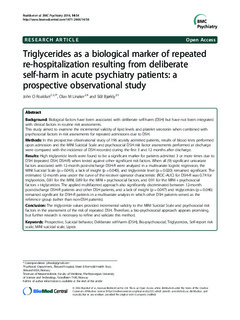| dc.contributor.author | Roaldset, John Olav | |
| dc.contributor.author | Linaker, Olav Morten | |
| dc.contributor.author | Bjørkly, Stål | |
| dc.date.accessioned | 2015-09-11T13:19:41Z | |
| dc.date.accessioned | 2015-10-07T11:06:17Z | |
| dc.date.available | 2015-09-11T13:19:41Z | |
| dc.date.available | 2015-10-07T11:06:17Z | |
| dc.date.issued | 2014 | |
| dc.identifier.citation | BMC Psychiatry 2014, 14(1) | nb_NO |
| dc.identifier.issn | 1471-244X | |
| dc.identifier.uri | http://hdl.handle.net/11250/2353153 | |
| dc.description.abstract | Background: Biological factors have been associated with deliberate self-harm (DSH) but have not been integrated with clinical factors in routine risk assessments. This study aimed to examine the incremental validity of lipid levels and platelet serotonin when combined with psychosocial factors in risk assessments for repeated admissions due to DSH.
Methods: In this prospective observational study of 196 acutely admitted patients, results of blood tests performed upon admission and the MINI Suicidal Scale and psychosocial DSH risk factor assessments performed at discharge were compared with the incidence of DSH recorded during the first 3 and 12 months after discharge.
Results: High triglyceride levels were found to be a significant marker for patients admitted 3 or more times due to DSH (repeated DSH, DSH-R) when tested against other significant risk factors. When all (9) significant univariate factors associated with 12-month post-discharge DSH-R were analyzed in a multivariate logistic regression, the MINI Suicidal Scale (p = 0.043), a lack of insight (p = 0.040), and triglyceride level (p = 0.020) remained significant. The estimated 12-month area under the curve of the receiver operator characteristic (ROC-AUC) for DSH-R was 0.74 for triglycerides, 0.81 for the MINI, 0.89 for the MINI + psychosocial factors, and 0.91 for the MINI + psychosocial factors + triglycerides. The applied multifaceted approach also significantly discriminated between 12-month post-discharge DSH-R patients and other DSH patients, and a lack of insight (p = 0.047) and triglycerides (p = 0.046) remained significant for DSH-R patients in a multivariate analysis in which other DSH patients served as the reference group (rather than non-DSH patients).
Conclusion: The triglyceride values provided incremental validity to the MINI Suicidal Scale and psychosocial risk factors in the assessment of the risk of repeated DSH. Therefore, a bio-psychosocial approach appears promising, but further research is necessary to refine and validate this method. | nb_NO |
| dc.language.iso | eng | nb_NO |
| dc.publisher | BioMed Central | nb_NO |
| dc.title | Triglycerides as a biological marker of repeated re-hospitalization resulting from deliberate self-harm in acute psychiatry patients: a prospective observational study | nb_NO |
| dc.type | Journal article | nb_NO |
| dc.type | Peer reviewed | en_GB |
| dc.date.updated | 2015-09-11T13:19:41Z | |
| dc.source.volume | 14 | nb_NO |
| dc.source.journal | BMC Psychiatry | nb_NO |
| dc.source.issue | 1 | nb_NO |
| dc.identifier.doi | 10.1186/1471-244X-14-54 | |
| dc.identifier.cristin | 1119367 | |
| dc.description.localcode | © 2014 Roaldset et al.; licensee BioMed Central Ltd. This is an Open Access article distributed under the terms of the Creative Commons Attribution License (http://creativecommons.org/licenses/by/2.0), which permits unrestricted use, distribution, and reproduction in any medium, provided the original work is properly credited. | nb_NO |
